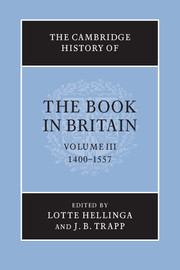Book contents
- Frontmatter
- Introduction
- 1 Literacy, books and readers
- TECHNIQUE AND TRADE
- COLLECTIONS AND OWNERSHIP
- READING AND USE OF BOOKS
- I BOOKS FOR SCHOLARS
- II PROFESSIONS
- 18 The canon law
- 19 The civil law
- 20 The books of the common law
- 21 Medicine and science
- III THE LAY READER
- Appendix
- List of abbreviations
- Bibliography
- Photo credits
- General index
- Index of manuscripts
- Bibliographic index of printed books
- Plate Section"
- References
20 - The books of the common law
from II - PROFESSIONS
Published online by Cambridge University Press: 28 March 2008
- Frontmatter
- Introduction
- 1 Literacy, books and readers
- TECHNIQUE AND TRADE
- COLLECTIONS AND OWNERSHIP
- READING AND USE OF BOOKS
- I BOOKS FOR SCHOLARS
- II PROFESSIONS
- 18 The canon law
- 19 The civil law
- 20 The books of the common law
- 21 Medicine and science
- III THE LAY READER
- Appendix
- List of abbreviations
- Bibliography
- Photo credits
- General index
- Index of manuscripts
- Bibliographic index of printed books
- Plate Section"
- References
Summary
Introductory
Although the common law of England was considered by academic lawyers as ‘unwritten law’, the upper branches of the English legal profession were necessarily learned in books. Chaucer’s man of law may not have owned books of cases literally stretching back to the time of the Conquest, but the poetic exaggeration must have worked upon fact; a serjeant at law was expected to possess an impressive array of law books. The library of a common lawyer in Chaucer’s day, or in 1557, would nevertheless have been unlike that of any other lawyer in the world. This was a result of the insularity of the English legal system, centred on the courts in Westminster Hall, which followed arcane procedures developed indigenously and was independent of Romanist terminology or method. Since the universities of Oxford and Cambridge disdained to notice a body of law that was not written in Latin and could not be expounded in lecturae, advanced instruction in the common law was provided by another university. The collegiate law school known as the Inns of Court probably dates from the 1340s, when it replaced a shadowy earlier studium for apprentices following the Common Bench. In addition to the four Inns of Court, there were a number of lesser colleges known as the Inns of Chancery, which provided lectures and exercises for less advanced students.
Though the writs and records of the law were in a sort of Latin, law French was used for virtually all professional literature. Probably it was no longer used for argument in court, but it was still spoken at exercises in the Inns of Court and was the only language in which formal pleadings could be framed orally at the bar before the clerks engrossed them in Latin. By 1450, law French was a language more often written than spoken, with its own arcane abbreviations. Though derived from the vernacular Anglo-Norman of the thirteenth century, it was as different from that of Stratford-atte-Bow as from that of Paris or Rouen. The words for trees and cows might be recognizably the same, but the lawyers had converted many ordinary words into a technical abstract vocabulary all their own. Even the Latin of our common lawyers was far removed from that of ancient Rome.
- Type
- Chapter
- Information
- The Cambridge History of the Book in Britain , pp. 411 - 432Publisher: Cambridge University PressPrint publication year: 1999
References
- 6
- Cited by

